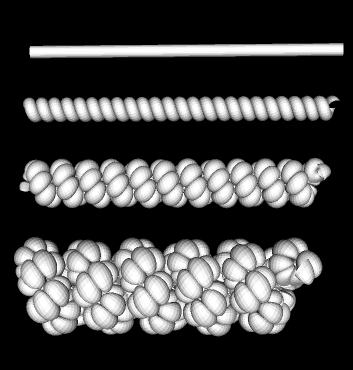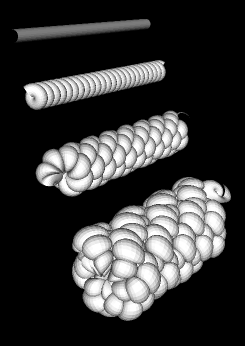

Tom Goddard September 2001
When a rubber band powered glider is wound up the rubber band forms twists and then forms a helical structure. With more twisting the helix gets wrapped into another thicker helix. Once a two level helix forms, allowing the ends to move together forms a third level helical structure.

|

|
| Figure 1: Top model is a tube. Second model from top shows tube wrapped to form a helix. Third model from top shows helix wrapped to form another helix. Bottom model wraps the 2 level helix into a 3 level helix. Each successive model is twice the diameter of the preceding one. The models were generated with Python code producing a VRML surface and displayed in Chimera. | |
This 3 level helix hierarchy is a model for how the 30 nm chromatin fiber is packaged into a condensed chromosome. The rubber band example demonstrates that the structure can form just using internal elastic forces and contact forces that prevent the fiber from passing through itself. The same physical mechanism could turn uncondensed chromatin into a condensed chromosome. Instead of twisting the chromatin, torsional stress could be induced by changing the environment ionic strength or by the action of proteins. The 30 nm chromatin fiber stucture has 10 nm diameter nucleosomes positioned in a zigzag pattern which John Sedat tells me is known to exhibit a helical arrangement. Each nucleosome has a little less than 2 turns containing ~150 bases of DNA wrapped around a histone octamer. The ends of the DNA come off the 5 by 10 nm aspirin tablet and cross and "linker" histone proteins are sometimes bound to these strands. Each nucleosome has about 50 bases of DNA that are not wrapped. Change in ionic strength or conformational modifications of linker histones could produce torsional and longtitudinal stress in the chromatin fiber by acting on the segments of DNA connecting the aspirin tablets.
An attractive aspect of this model is that it does not use stickiness to fold the chromatin. It does not involve proteins that stick sections of chromatin to each other or hydrophobic effects. After the DNA is replicated prior to cell division, it must separate into two sister chromosomes. It appears nearly impossible to avoid sticking the two copies DNA to one another if packaging involved stickiness. The rubberband model thickens in stages, approximately doubling its diameter with each added helix level. This thickening in steps seems well suited to avoid tangling two parallel copies of chromatin from replicated DNA. This model also nicely accounts for why the chromosome is sausage shaped instead of a big ball. It is difficult for a theoretical model of chromosome packing to produce the sausage shape because something must set the relatively long length scale of the chromosome diameter. Building up successively thicker helices solves this in a simple way.
Wrapping a cylindrical fiber into a helix that does not leave a big hole down the central axis requires very tight bending of the fiber. A piece of braided cord easily takes this shape. But the cord helix does not bend easily enough to make a second level helix. The 3 level helix shown in the figure compresses the packaged fiber near the central axis of the model by a large factor. That is not physically reasonable.
A twisted rubber band forms double helical loops if less longtitudinal stretching is done than the scenario described above. These loops bend the fibers much less, ie the curvature is much less. A model built from twisted double helical loops may avoid unphysical compressions.
The basic idea that the packing of chromatin in a chromosome is carried out by elastic forces internal to the chromatin fiber constrained by contact forces which prevent the fiber from passing through itself looks promising.
I would like to compute dynamics for a simple fiber model having torsional, longtitudinal, bending and contact forces. The contact forces will prevent the fiber from passing through itself. Starting with a straight fiber, torsion and longtitudinal stress will be turned on at different rates and the resulting fiber folding will be determined. I'll explore the range of packings this model can produce.
A fiber of circular cross-section can be wrapped into a helix so that each turn stacks on top of the preceding turn. This configuration is characterized by the fiber radius r and the helix radius R. The curve describing the helix is:
x = R * cos(2*pi*z/H) y = R * sin(2*pi*z/H)
where axis of the helix is the z axis. The fiber center lies on this curve. The distance along the z axis traversed in one turn is H. H is determined by the condition that the turns of the fiber helix stack on top of each other. It is a function of fiber radius r and helix radius R.
Playing with a piece of cord suggests that the helix radius cannot be reduced too much below the fiber radius. I thought this might be because below a certain helix radius an additional contact of the fiber with itself about a half turn away prevented further shrinking. This is not the case. No additional contacts occur as the helix radius is reduced. The helix radius of curvature will become smaller than the fiber radius. When the curvature matches the fiber radius, the surface of the fiber along inside of the bend is compressed to nothing, while the outside edge of the fiber is stretched by a factor of 2. Bending further makes the fiber crimp or self intersect like a bagel without a hole. A real piece of cord can distort its cross-section to be non-circular. Reducing the helix radius further and the turn on top of turn concept breaks down because no point fiber tangency is possible when the helix pitch becomes too large.
Here are some parameters concerning a helix made from a fiber of circular cross-section with turn stacked on top of turn.
r = fiber radius
R = helix radius
H = helix rise for one turn
rho = helix radius of curvature
d = cross helix minimum distance
Minimum fiber tangency helix turn angle x = 2pi * 0.715
r/R beyond which no fiber tangency is possible = 1.31
H/2R beyond which no fiber tangency is possible = 1.46
r/R where helix radius of curvature equals fiber radius = 1.16
r/R rho/r d/2r
0.13058 7.6713 7.6744
0.26116 3.8557 3.862
0.39174 2.593 2.6027
0.52232 1.9689 1.9824
0.65291 1.6008 1.6185
0.78349 1.3611 1.3838
0.91407 1.1954 1.2243
1.0446 1.077 1.1137
1.1752 0.99133 1.0391
1.3058 0.93217 1
Laboratory Overview | Research | Outreach & Training | Available Resources | Visitors Center | Search